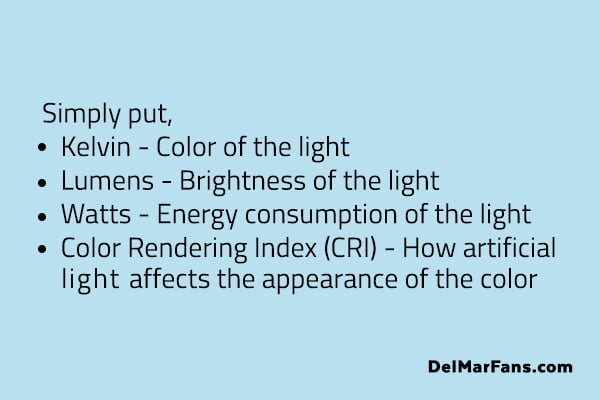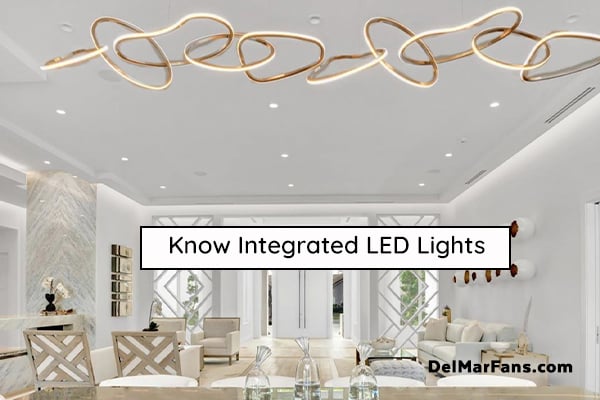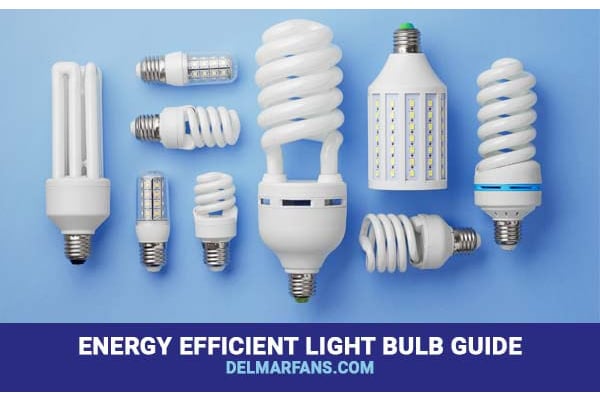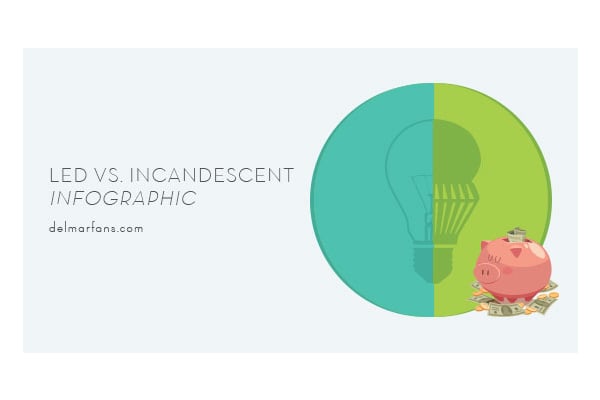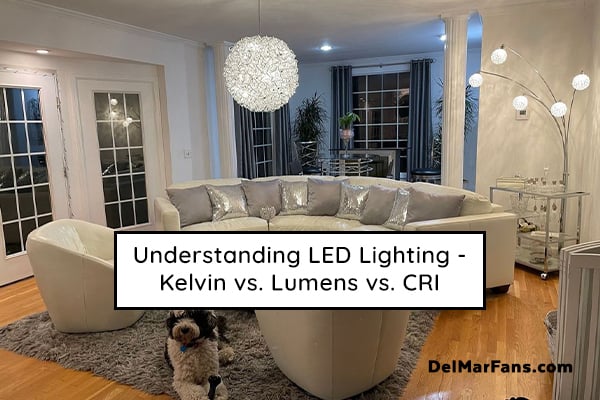
LED lights have revolutionalized the lighting industry with their high energy efficiency and extended lifespan. Simply described, an LED, or light-emitting diode, is a semiconductor device and when an electrical current flows through it, a visible "directional" light is created. In comparison to incandescent, halogen, and other conventional light bulbs, LEDs have a longer life span that dims gradually over time when it is about to "burn out"; consume no energy in the production of heat, and generate "uni-directional" brightness. Being smaller in size, LEDs light bulbs are versatile in designing functionally efficient decorative fixtures (including light kits in ceiling fans).
Detailed comparison of LED vs Incandescent vs Halogen.
Let us help to understand the characteristics of LED lighting in terms of Kelvin, Lumens, and Color Rendering Index (CRI). By understanding these details, you will be better equipped to make an informed decision for the right lighting in your space, and to meet your requirements.
What is Kelvin?
Kelvin (K) is a unit of measurement for light bulb color temperature. It refers to the hue of the light emitted by the LED and is expressed in degrees of Kelvin (K). Incandescent light bulbs usually produce warm light with a color temperature of 2700K to 3000K.
LEDs bulbs can produce a wider range of colors, from more yellow warm (2700K) to more blue cool tones (6500K).
The lower the Kelvin scale value, the warmer and more yellow the light appears, while the higher the Kelvin value, color appearance is a blue, cool light. Most ceiling fans and light fixtures will have a 3000K rating as this is typical for everyday uses.
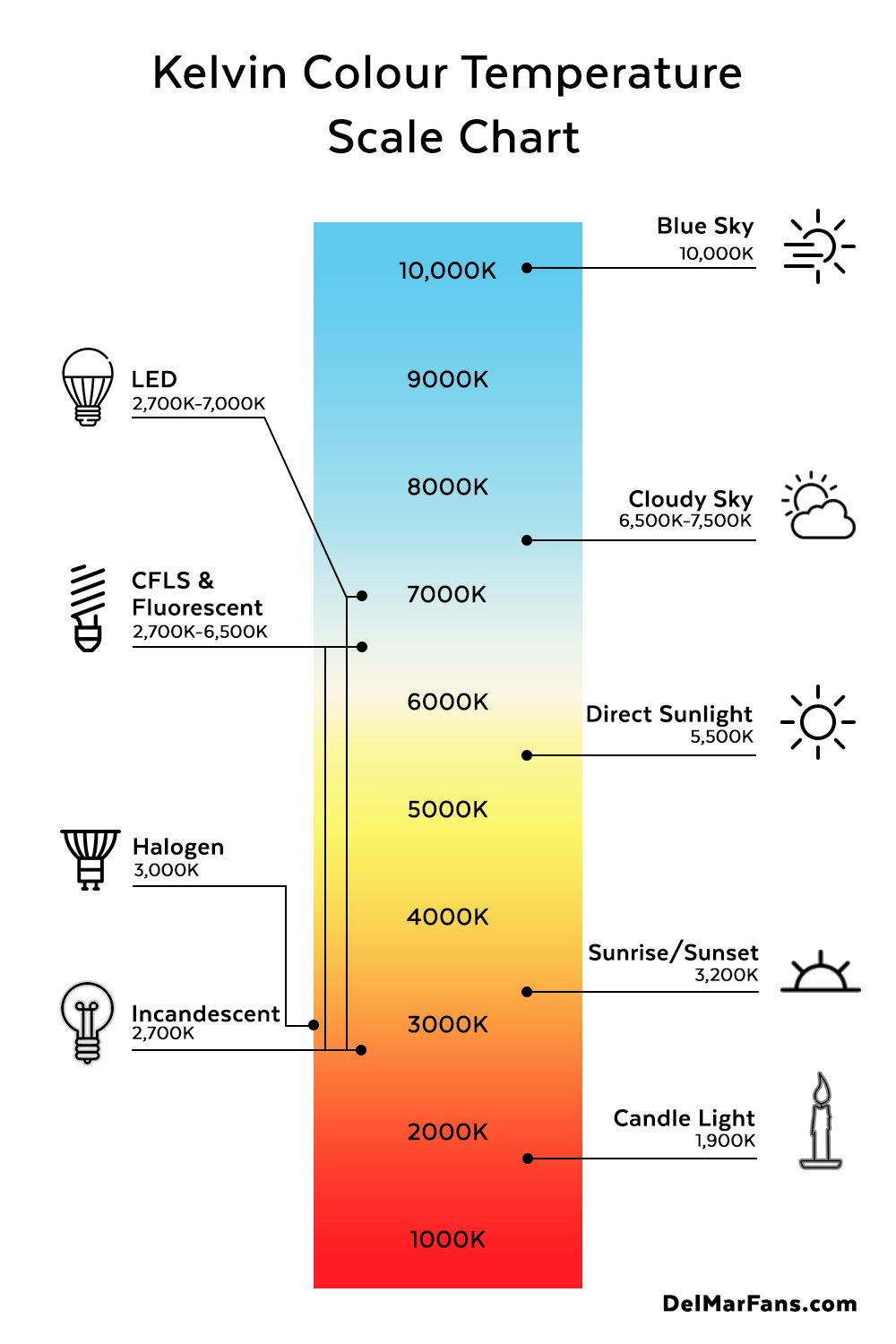

Kelvin is inherent in nature through the sunlight. We are most alert during the daytime and as the daylight mellows down to the hues of orange and red, we are calmer and feel more relaxed. That’s Kelvin in action!
Kelvin - Color Temperature Applications:
Color temperature is crucial when deciding the lighting scheme in the room. You do not want your employees to be sleepy in the office or want bright uncomfortable light in your bedroom after a long busy day! Think about the activity to be done in that space and what mood you want to be set in there - these will define what color temperature LED light would suit you. Here are the general guidelines for you to refer to which area and purpose require how much Kelvin.
Warm Color temperature:
2700K to 3000K range on the light color chart is warm and in the hues of reds and yellows. Gentle, and comfortable, this range is inviting and exudes relaxing vibes. It compliments skin tones and creates a cozy ambiance, making it a popular pick for bedrooms, living rooms, and the hospitality industry.
Moving up, the 3100K - 4000K range varies from soft white to neutral to bright white light, with the higher end starting to show a slight blue tint. Perfect for visual tasks, this range is particularly picked for kitchens, bathroom vanity, laundry room, home office, and office/work spaces. Here, more than warmth in light, clarity is important.
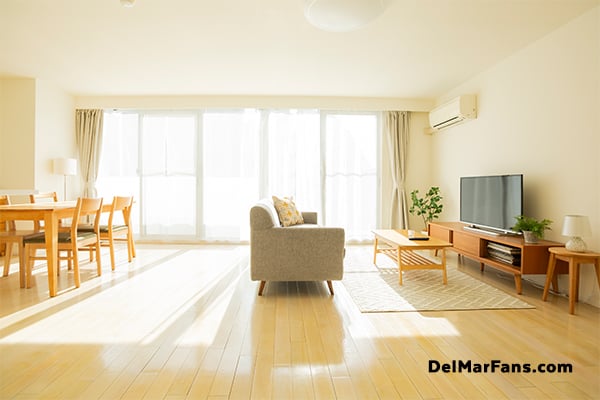

Cool Color Temperature:
4100K - 5000K - When the task in hand requires precision, cool white light is what you want. It is mostly required for industrial and commercial settings like grocery stores, and professional garages where workers need crisp light to work on intricate details. The 4000K to 4500K range is used for residential outdoor lighting and security lighting.
5100K - 6400K - Some places still require higher accuracy and ultimate clarity when at work for instance sports stadiums, hospitals, and warehouses.
6500K and higher have an apparent blue tone. It is commonly used for indoor farming, greenhouses, and other agricultural purposes.
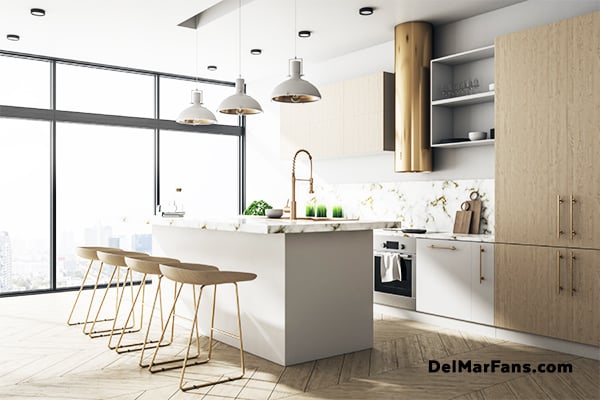

Kelvin and Home Décor
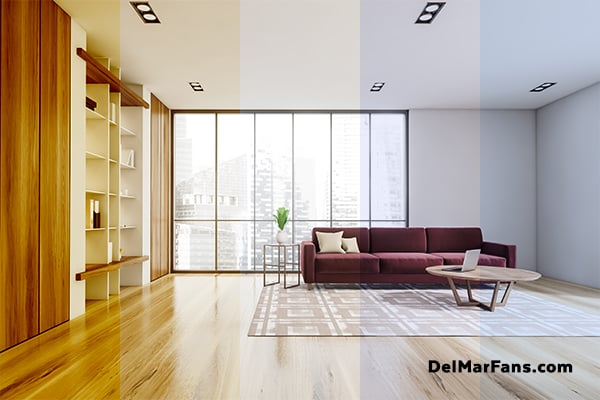

The color temperature is an important consideration in home décor too. The color palette and finishes should be in consideration while choosing the color temperature. A living space with reds, yellows, and earthy wood hues will look beautiful under warm white light. The cool white color will rather dampen its coziness. Similarly, the greys and blues look amazing in cool white color light, and white makes a statement with its sharp appearance. It is advisable to use cooler LEDs where sunlight is sufficiently available like in bathrooms and kitchens where it gives a ‘neat’ look. On the contrary, a warm LED here makes a white surface look filthy.
It is imperative to stick to the warm or cool white light depending on the room décor once you have furnished your room. Mixing color temperatures can ruin the whole ‘feel’ of your space.
What is Watts?
Watts (W) is a measure of the energy consumption of a light fixture. LED lights are highly energy efficient and typically consume much less energy than traditional incandescent bulbs in making an equivalent bright light output i.e. lumens. Choosing LED lights with lower wattage can help you save on energy costs over time.
What is Lumens?
Lumen (lm), in simple terms, is the light bulb’s brightness.
It measures the total amount of light emitted in all directions by a light source and is expressed in Lumens (lm). The higher the number of Lumens, the brighter the light. Both LEDs and traditional lights use lumens to quantify how much light they produce. LEDs are able to produce more lumens at lower watts than incandescent bulbs. Therefore, when upgrading your traditional lights to LEDs, it is important to compare the lumens produced, not the wattage.
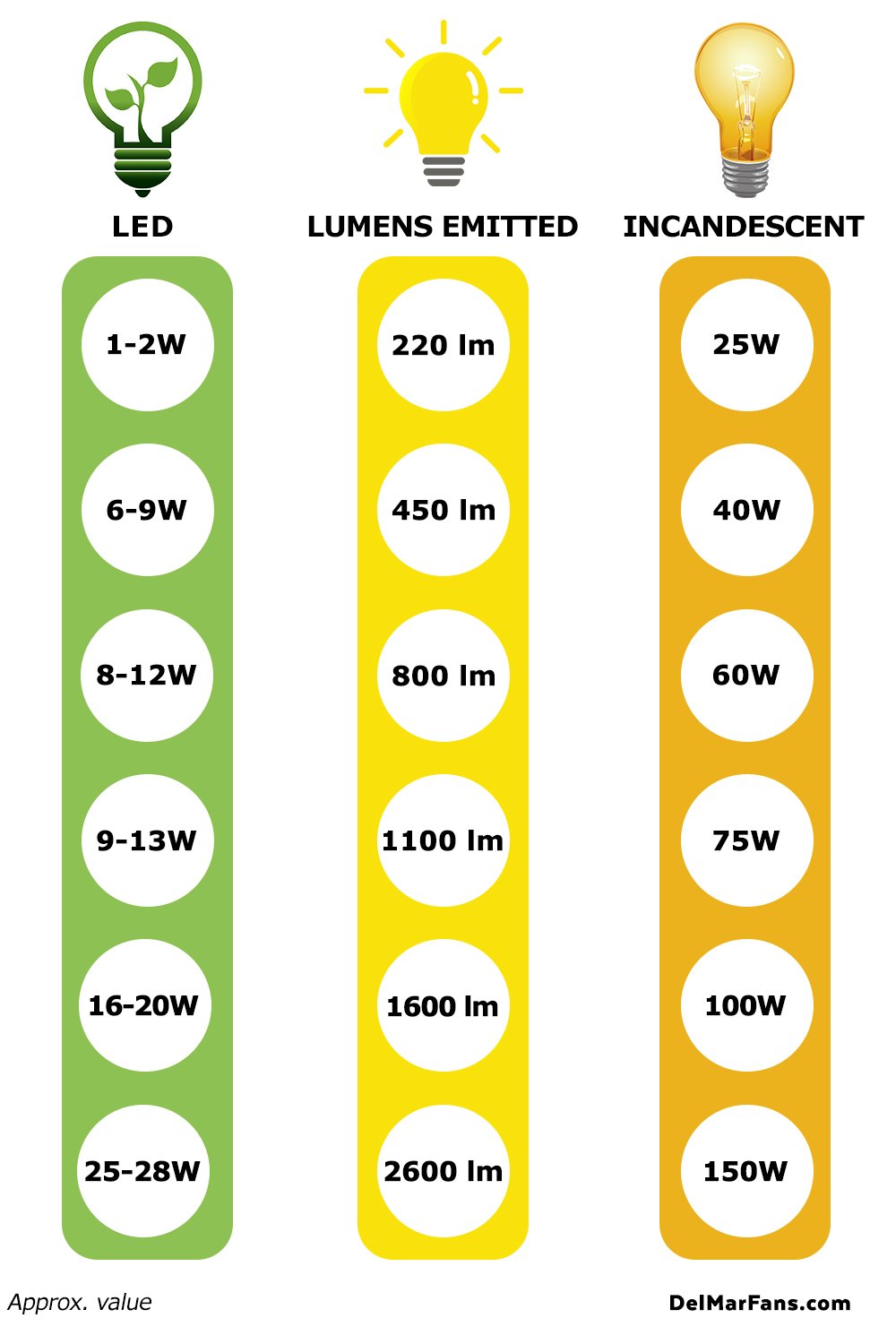

Are Lumens and Kelvin Correlated in LED light?
Blue-toned higher Kelvin lights are generally understood to deliver higher lumens than yellow-toned lights. But, this is NOT TRUE.
THERE IS NO CORRELATION BETWEEN KELVIN AND LUMENS.
Light bulbs can have a low lumen output with a high color temperature or a high lumen output with a low color temperature. Given the developments in technology, it is impossible for any two bulbs to have exactly the same brightness and color temperature.
What is Color Rendering Index (CRI)?


The Color Rendering Index (CRI) gauges how precisely colors may be rendered by a light source. It has a significant impact on how objects seem to us under artificial light. If the CRI is 100, the light source accurately reproduces the colors as they would look in the sunlight. Offices and homes frequently employ LED lights with a CRI value of 80, and these lights are frequently acceptable. As their work requires delicate precision in hue and color tone separation, visual artists prefer displays with high CRI (>90) because they are sharp and attain a higher degree of accuracy. It guarantees that the interior color palette in residential situations is cohesive.
When deciding on CRI, it is important to choose what your budget permits especially in case of lighting bathrooms, kitchens, artwork, restaurants, and retail spaces.
Kelvin vs. Lumens vs. CRI - What Is More Important When Selecting A LED Bulb?
The answer lies in your purpose and requirements. What tasks or activities do you intend to do?
For a relaxing ambiance lower Kelvin and lower lumen LED light bulb will do. However, for task lighting, both color and brightness are crucial. Cooking in the kitchen, for instance, mid-level cool color temperature 4000K - 5000K works well, but you cannot compromise on brightness either. Your kitchen must be optimally and carefully illuminated as it involves dealing with knives, too hot and too cold temperatures. You need a high-lumen output light source for you to see what you are doing. Making the decision on whether your food is cooked well or not and how it looks depends majorly on the light’s CRI.
Why Buy From Del Mar Fans & Lighting?
There are many reasons to buy from Del Mar Fans and Lighting, however, here are just a few reasons we would like to bring attention to!
- Returns for 90 days.
- Free shipping on all orders of $40+.
- A safe shopping experience.


